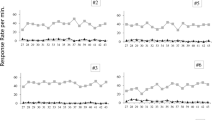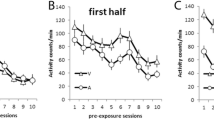Abstract
Previous studies have shown that pipradrol enhances the acquisition of responding with conditioned reinforcement. The present experiments replicated this finding and assessed the possible role of nonspecific stimulus change, feeding in the test environment and procedure consisted of three phases: Operant rates of pressing two levers, one of which produced a 3-s tone, were measured in the pre-exposure phase; the tone was paired with food in the four conditioning sessions; and conditioned reinforcement was demonstrated in the test phase by a relative increase in pressing the tone lever. A group (N=8) receiving food but no tone during the conditioning phase also increased responding on the tone lever in the test phase and this effect was enhanced in a group (N=8) receiving pipradrol prior to the test. A group (N=8) receiving neither tones nor pellets during conditioning and pipradrol prior to test failed to show a change in lever bias, ruling out the possibility that pipradrol produced a nonspecific enhancement of responding for stimulus change. It was hypothesized that the conditioned reinforcement effect seen in the food-alone groups resulted from sensory preconditioning. According to this hypothesis, the tone was conditioned to environmental stimuli during the pre-exposure phase; subsequent presentation of pellets resulted in a learned association between environmental stimuli and food, leading to increased responding for the tone in the test phase. The results of two control experiments supported this view. One group (N=8) received no tone in the pre-exposure phase, pellets alone in the conditioning phase and then pipradrol prior to test. The second group (N=8) received pellets alone in the conditioning phase, but under altered environmental stimulus conditions, and then was given pipradrol prior to test. Neither group showed evidence of conditioned reinforcement. It was concluded that pipradrol enhanced acquisition of responding with conditioned reinforcement even if the conditioned reinforcing stimulus was established with sensory preconditioning procedures.
Similar content being viewed by others
References
Beninger, R. J., Phillips, A. G.: The effect of pimozide on the establishment of conditioned reinforcement. Psychopharmacology 68, 147–153 (1980)
Brogden, W. J.: Sensory preconditioning. J. Exp. Psychol. 25, 323–332 (1939)
Bugelski, R.: Extinction with and without sub-goal reinforcement. J. Comp. Psychol. 26, 121–134 (1938)
Hill, R. T.: Facilitation of conditioned reinforcement as a mechanism of psychomotor stimulation. In: Amphetamines and related compounds (E. Costa, S. Garattini, eds.), pp. 781–795. New York: Raven 1970
Knott, P. Q., Clayton, K. N.: Durable secondary reinforcement using brain stimulation as the primary reinforcement. J. Comp. Physiol. Psychol. 61, 151–153 (1966)
Lyon, M., Robbins, T.: The action of central nervous system stimulant drugs: A general theory concerning amphetamine effects. In: Current developments in psychopharmacology, Vol. 2 (W. B. Essman, L. Valzelli, eds.), pp. 79–164. New York: Spectrum 1975
Mackintosh, N. J.: The psychology of animal learning. London: Academic 1974
Overton, D. A.: Experimental methods for the study of statedependent learning. Fed. Proc. 33, 1800–1813 (1974)
Pinder, R. M., Brogden, R. N., Sawyer, P. R., Speight, T. M., Spencer, R., Avery, G. S.: Pimozide: A review of its pharmacological properties and therapeutic uses in psychiatry. Drugs 12, 1–40 (1976)
Robbins, T. W.: The potentiation of conditioned reinforcement by psychomotor stimulant drugs. A test of Hill's hypothesis. Psychopharmacologia 45, 103–114 (1975)
Robbins, T. W.: Relationship between reward-enhancing and stereotypical effects of psychomotor stimulant drugs. Nature 264, 57–59 (1976)
Robbins, T. W.: The acquisition of responding with conditioned reinforcement: Effects of pipradrol, methylphenidate, d-amphetamine, and nomifensine. Psychopharmacology 58, 79–87 (1978)
Robbins, T. W., Koob, G. F.: Pipradrol enhances reinforcing properties of stimuli paired with brain stimulation. Pharmacol. Biochem. Behav. 8, 219–222 (1978)
Seidel, R. J.: A review of sensory preconditioning. Psychol. Bull. 56, 58–73 (1959)
Scheel-Kruger, J.: Comparative studies of various amphetamine analogues demonstrating different interactions with the metabolism of the catecholamines in the brain. Eur. J. Pharmacol. 14, 47–59 (1971)
Skinner, B. F.: The behavior of organisms. New York: Appleton Century Crofts 1938
Stein, L.: Secondary reinforcement established with subcortical stimulation. Science 127, 466–467 (1958)
Stein, L.: Effects and interactions of imipramine, chlorpromazine, reserpine and amphetamine on self stimulation: Possible neurophysiological basis of depression. Rec. Adv. Biol. Psychiatry 4, 288–308 (1962)
Stein, L.: Amphetamine and neural reward mechanisms. In: Animal behavior and drug action (H. Steinberg, ed.), pp. 91–113. Boston: Little Brown 1964
Thompson, R. F.: Sensory preconditioning. In: Topics in learning and performance (R. F. Thompson, J. F. Voss, eds.), pp. 105–129. New York: Academic 1972
Verhave, T.: The effect of methamphetamine on operant level and avoidance behavior. J. Exp. Anal. Behav. 1, 207–220 (1958)
Weiss, B., Laties, V. G.: Effects of amphetamine, chlorpromazine, and pentobarbital on behavioral thermoregulation. J. Pharmacol. Exp. Ther. 140, 1–7 (1963)
Zimmerman, D. W.: Sustained performance in rats based on secondary reinforcement. J. Comp. Physiol. Psychol. 52, 353–358 (1959)
Zimmerman, D. W.: Influence of three stimulus conditions upon the strength of a secondary reinforcement effects. Psychol. Rep. 13, 135–139 (1963)
Author information
Authors and Affiliations
Rights and permissions
About this article
Cite this article
Beninger, R.J., Hanson, D.R. & Phillips, A.G. The effects of pipradrol on the acquisition of responding with conditioned reinforcement: A role for sensory preconditioning. Psychopharmacology 69, 235–242 (1980). https://doi.org/10.1007/BF00433088
Received:
Accepted:
Issue Date:
DOI: https://doi.org/10.1007/BF00433088




